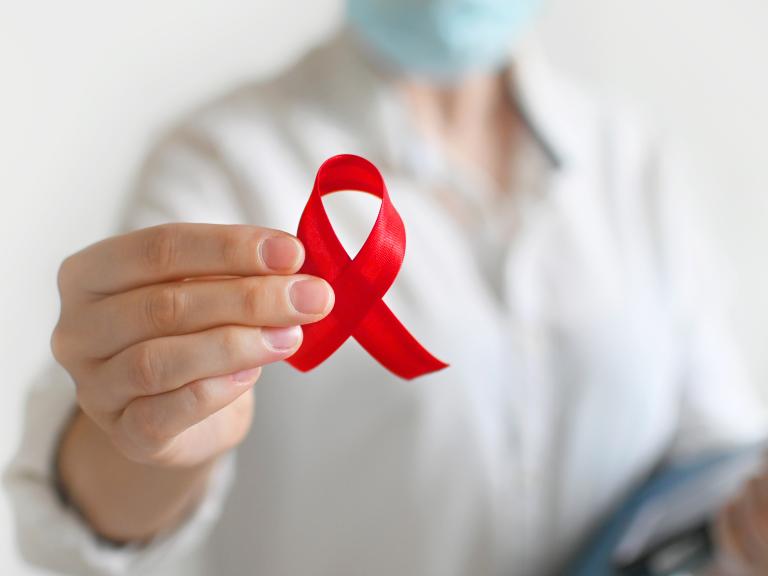Authors
Liberty A. Walton, Brandie K. Taylor, Larry S. Solomon, Stuart Z. Shapiro & Angela Malaspina


Liberty A. Walton, Brandie K. Taylor, Larry S. Solomon, Stuart Z. Shapiro & Angela Malaspina
You may download a PDF of the infographic for a full description or printing. To print, after downloading the PDF, select “fit to page” in printer settings. Larger paper sizes will yield best results. For web posting, the NIAID Flickr site offers a high-resolution JPEG.
By Carl W. Dieffenbach, Director of the Division of AIDS, National Institute of Allergy and Infectious Diseases, National Institutes of Health
The Division of AIDS (DAIDS) supports a number of programs, networks, and studies to increase basic knowledge of the pathogenesis and transmission of HIV, promote the development of therapies for HIV infection and its complications and co-infections, and encourage the development of vaccines and other prevention strategies.
Over the years, these networks, programs, and studies have amassed a wealth of longitudinal data that provides detailed information on the natural history and clinical and laboratory course of HIV disease in various populations. In addition, biological specimens from well-characterized individuals and/or cohorts have been collected and stored in centralized and local repositories.
Through the Division of AIDS (DAIDS) specimen repository contract, BBI Biotech Research, Inc., provides state-of-the-art storage and computerized inventory management of specimens from domestic and international HIV epidemiology studies, HIV therapeutic and vaccine trials, and other prevention research studies through its central repositories.
NIAID’s four HIV/AIDS scientific priorities are:
Each network holds two to three large meetings per year.
The NIAID HIV/AIDS Clinical Trials Networks have been designed to address NIAID’s four HIV/AIDS scientific priorities.
The Networks include:

Read about shaping the future of the NIH HIV Clinical Trials Networks by visiting HIV Clinical Research Enterprise.
The original MACS collected and stored a variety of biological specimens. Inventory may be housed at the national level or a subset at the local level. The now combined MACS-WIHS Combined Cohort Study (MWCCS) Data Analysis and Coordinating Center (DACC) coordinates and facilitates completion of specimen requests.
The IeDEA Cohort Consortium collaborates to collect and define key variables, harmonize data, and implement methodology to effectively pool data as a cost-effective means of generating large data sets. IeDEA collects HIV/AIDS data from seven international regional data centers, including four in Africa, and one each in the Asia-Pacific region, the Central/South America/Caribbean region, and North America.
Read more about this network: IeDEA Cohort Consortium
The Women's Interagency HIV Study (WIHS) was established in 1993 as a multi-center, prospective, observational cohort study of women living in the United States. The study was expanded in 2012 to additional locations and by study completion in 2018 had been conducted at clinical research sites in Atlanta, GA; Birmingham, AL/Jackson, MS; Chapel Hill, NC; Chicago, IL; Miami, FL; New York City, NY; Los Angeles, CA; San Francisco, CA; Washington, DC. Participants were representative of the population of women living within these geographical regions and either living with HIV or behaviorally vulnerable to HIV at the time of enrollment. Biological and behavioral data were collected every six months; limited autopsy samples and saliva may be available also. The study was merged in 2019 with the Multicenter AIDS Cohort Study (MACS) under a unified study comprising a cohort of men and women, known as the MACS-WIHS Combined Cohort Study (MACS-WIHS CCS).
Read more about this network: Women's Interagency HIV Study (WIHS)
The MACS-WIHS CCS Executive Committee (EC) is responsible for managing the specific aims of the WIHS and is composed of the Principal Investigators (PIs) from each awardee institution, a MWCCS National Community Advisory Board (NCAB) member selected by study subjects to represent their interests, and a Project Scientist from each current co-funding NIH Institute.
A Dossier that contains a list of ongoing and completed core aims and substudies, cohort and retention status, baseline characteristics, mortality rates, and ARV use status has been maintained since the study began. The Dossier also summarizes key study characteristics and scientific contributions from WIHS publications. The Dossier is updated annually and can now be found on the MACS-WIHS CCS website.
PEPFAR is the U.S. government initiative to help save the lives of those living with and affected by HIV/AIDS around the world. This historic commitment is the largest by any nation to combat a single disease internationally, and PEPFAR investments also help alleviate suffering from other diseases across the global health spectrum. PEPFAR is driven by a shared responsibility among donors, host countries, and other partners to make smart investments to save lives and, ultimately, end the AIDS epidemic by 2030.
Read more about this network: U.S. President's Emergency Plan for AIDS Relief
PEPFAR is led and managed by the U.S. Department of State's Office of the U.S. Global AIDS Coordinator and Health Diplomacy and implemented by seven U.S. government departments and agencies, leveraging the power of a whole-of-government approach to controlling the HIV/AIDS epidemic.
PEPFAR has funded Implementation Science grants through a series of individual NOFOs, released by NIH, CDC, and/or USAID.